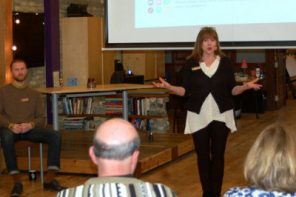Kids come and go from schools; it’s just the nature of things. But thanks to Artists Working in Education, many Milwaukee children are making a lasting mark on their schools.
A group of Milwaukee art teachers, artists and museum curators organized A.W.E. in 1998 as a reaction to funding cuts in art education and with the mission “to provide youth in the Milwaukee area with arts enrichment programs to enhance human potential, advance learning and cultivate community.”
A.W.E. works toward its mission via a mobile truck studio and through artist-in-residence programs at Milwaukee schools.
Among about a dozen projects this semester is one that’s just wrapping up at MPS’ Frances Starms Early Childhood Center, 2616 W. Garfield St., which serves about 300 3-6-year-olds on the North Side.
The four-week program at Starms finds kindergarteners collaborating with author and illustrator Francisco X. Mora, Becki Johnson – a part-time art teacher at Greenfield’s Edgewood Elementary – and Starms’ full-time art teacher Karina Kroll on a project that will beautiful the basement of the 1893 schoolhouse that was previously home to Elm Street School.
Students drew pictures of insects and animals that live or burrow underground and are painting them and decorating rocks, too. All of the work will hang underground on the basement walls, which have been painting brown along the lower half to represent the soil.
“Our students (are) obviously very eager and feeling quite energetic about the entire A.W.E. mural project,” says Kroll. “It really has been an enriching experience trying to transform our basement level into an underground community of tunnels/burrows of mammal and insect homes.
“I’m hoping that these investigations and art experiences will help students see how life above ground connects to life below,” she says.
The students started by reading about underground life and looking at images of the kinds of insects and animals that live underground. Then, they began drawing.
And the drawings are quite amazing, considering that these kids are 5 and 6 years old. But Kroll isn’t surprised.
“They never cease to amaze me,” Kroll says of her students.
“You can tell the schools where kids have art,” adds Johnson. “At a school (with no art teacher), this would be third grade work.”
A.W.E. Program Director Ali Carlucci says the residency at Starms is a little unusual for the non-profit, which tends to work with older kids, typically from third-12th grade.
This semester, she says, there have been residencies at Oliver Wendell Holmes, Bay View Middle School, Samuel Clemens, Shalom High School, La Causa and Alliance High School, among others.
“This is a younger group than we typically work with,” she says. “We decided to give it a shot. I think these drawings are absolutely beautiful. They’re so funky. I would buy (them)!
“These types of projects can really make an impact. (The kids) are being creative and they’re in charge. (They) get to change space at the personal level. It’s an opportunity to be part of a permanent installation to be proud of as they grow up.”
Kroll says once the mural project is finished the kids will make objects from the same materials that they can take home as a memento of their collaboration with the artists.
Once the project is completed, the school will have an unveiling party to celebrate.
“There’s this whole school buy-in,” says Kroll. “They’re all talking about it. They’re super excited about this project.”
On the day I visited, Kroll, Johnson and Mora were working with groups of kids at a variety of stations. Some children did finishing work on the animal and insect paintings with metallic paint. Others were painting the rocks using a variety of brushes and media to create patterns with paint. Still more were engaged in other tasks.
There was a joyful din in the air and smiles all around. These kids were engaged in creativity, thinking about science – talking about differences and traits of the creatures they were working on – and having an absolute blast. It’s what good quality, project-based early childhood education ought to look like.
“We try to hire professional artists and professional artists from different disciplines,” says Carlucci. “It’s about professional development for them, too, as well as helping them believe that they really can be educators. It’s really about bringing their voices into it.
“The residency really ties into (the students’) science curriculum. It’s another experience to help them learn.”
The kids typically bond with the A.W.E. residents immediately, says Kroll.
“They’re very sweet,” she says. “Right away they’ll say, ‘we just love you,’ They get a lot of hugs.”
And she appreciates them, too, for creating varied opportunities for her classroom.
“I’ve done four of five projects with them over my career teaching art in Milwaukee,” she says. “If I would’ve done it alone it would’ve turned out very differently, so it’s to work collaboratively with other artists. It’s just a way to get different minds working together.
“It’s nice to shake things up and do a something a little different.”


 i evaluate to yes even if there's no image
i evaluate to yes even if there's no image  i evaluate to yes even if there's no image
i evaluate to yes even if there's no image  i evaluate to yes even if there's no image
i evaluate to yes even if there's no image  i evaluate to yes even if there's no image
i evaluate to yes even if there's no image  i evaluate to yes even if there's no image
i evaluate to yes even if there's no image  i evaluate to yes even if there's no image
i evaluate to yes even if there's no image 